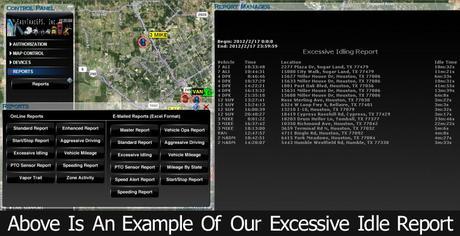For the average fleet manager the challenges and pressures of operating a safe, efficient, and profitable trucking fleet are an everyday struggle….a balancing act that never seems to end. Oil prices are an unfortunate reality….where daily price variances and purchasing decisions could potentially mean the difference between making a profit and taking a loss. Driver safety, or more specifically negative driving behavior, can cause a fleet manager to lose a good amount of sleep as well. This is a stressful position to be put in, to be sure! Making an investment in GPS tracking technology as a fleet management tool can potentially be a powerful asset…..POTENTIALLY. However, time and again we see mixed results or lack of a substantial improvement in overall fleet trucking operations. You might ask yourself why this is…..we did too at one point. What we found at EasyTracGPS is that, as a provider of our products and services to fleets nationwide, we have an obligation and responsibility to not only offer a solution to a problem but to coach our clients on achieving maximum results as well. The x-factor that most fleet operators seem to miss is that successful “implementation” is KEY to realizing the full power and potential of the technology….it can give mile-by-mile ”ride-along” visibility into the entire fleet, directly from the terminal. Companies invest in the technology and have it at their disposal, why not maximize the potential?! GPS tracking & vehicle telematics systems can, if properly integrated into a fleet trucking operation, completely change the manner in which a company operates and conducts business on a day-to-day basis.

To restate, the vast majority of fleet managers are focused on three main areas of concern….fuel consumption, driver performance, and safety. Let’s direct our attention to the subject of fuel and some tips and techniques that can put any trucking fleet on a path to greater efficiency and healthier profits.

The oil companies are the 800 lb. gorilla…we are ALL at the mercy of the games that they play and so much is out of our control. However, there are things a company can do to help mitigate the effects of their greed. Outside of factors such as areodynamics, drive-train losses, gearing, lubricants, engine maintenance, etc., there are additional improvements that can be made. In this case, fuel efficiency and driver performance go hand-in-hand and are linked.
When I mention driver performance, I’m referring to the manner in which a rig is being operated when on the road, outside of management’s control. Most would think that “idle time” would have the greatest singular impact on fuel cost in trucking fleets and, in some cases, you would be correct. Please don’t misunderstand, “idle time” is HUGE….but definitely not the only thing to consider.

In long-haul trucking fleets, drivers spend many hours on the road….essentially turning their sleeper/cab into a studio apartment…at times complete with TV, microwave oven, etc. It’s hard to find good, qualified drivers these days and when a fleet manager does find a good employee, they want to keep them happy. Making sure a driver is comfortable when on the road is an important consideration. In the summer, the driver needs to run the air conditioning and in the winter, the heat. APUs (Auxiliary Power Units) can power these systems but, if an APU isn’t present, sometimes the truck runs and idles the entire night. It’s a necessary evil and the cost of doing business but it definitely isn’t friendly to fuel efficiency or the bottom-line. This is a factor that fleet operations take into account and plan for since, when the rig is down for the night, RPMs can usually be adjusted to the lowest level possible to maintain cab and bunk temperatures (somewhere around 800 RPMs give-or-take). That’s the carrot….now here’s the stick.
What happens while the driver is on the road is something that, at times, cannot be planned for. Negative driver performance can cause unnecessary waste of valuable fuel and is something that, with proper implementation of a fleetwide fuel savings initiative, can be significantly reduced and controlled. Besides “idle time”, two critical areas that cause negative fuel management are sudden acceleration and deceleration….essentially aggressive driving behavior or ”the curse of the lead foot”. As you can see below, our ComTrac Total Tracking Solution™ measures rapid acceleration/deceleration over a period of 10 seconds and pro-actively makes that “actionable” information available to the fleet manager LIVE, in real-time. Not only can this waste fuel TODAY, but it leads to increased wear-and-tear on the engine and a shorter “shelf-life” of the rig. Increased wear-and-tear equals decreased fuel efficiency, and subsequently increased fuel and maintenance costs for the company. Thankfully, through ongoing training and the setting of fuel saving objectives for the fleet, this is a problem that can be addressed and improved upon.

It all starts before the rig gets on the road, and one way that fleet managers begin to ensure optimal fuel efficiency is by training their drivers on the “Pre-Trip Inspection”. Drivers should be checking engine lube oil levels, tire pressure levels, service brake adjustments, air system leaks, the coupling device, etc…as each of these contributes to improved fuel economy.

Training drivers on proper shifting techniques is the first “on-the-road” introduction of the human element into the equation and poor driver performance in this area can be quite costly. As a rule of thumb, the lower the consistent RPMs the better the fuel efficiency of the rig….with continual operation under 1300 RPMs resulting in significantly improved fuel economy. In big rigs, the higher the gear the lower the RPMs so drivers should strive to spend as much time in “top gear” as possible and to use the full range of the engine before gearing down….of course, the heavier the load the more difficult this is to achieve but the truck’s on-board ECM (Electronic Control Module or on-board diagnostic computer) should compensate for this. Over the course of a several thousand mile trip, this will yield a significant improvement in the overall fuel economy of the rig.
Part II Coming Soon


